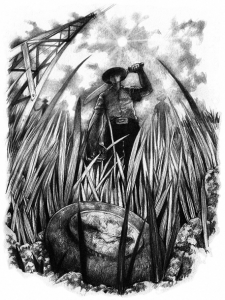Landmines are the perfect weapon in war, the best strategy to debilitate the enemy, hindering their advance and controlling influence zones. They are used as lethal tools, forbidden by internationals treaties. Nonetheless, in the east of Antioquia (Colombia) the number of victims doesn’t diminish and tragedies continues.
Between 1990 and the 31th of mars 2017, there were 11.538 victims of landmines and unexploded ordnance, where 39% were civilians and the rest came from the Colombian army. Cocorna is a municipality at the east of Antioquia with one of the highest number of landmine victims. Among its 76 villages, 21 were mined by revolutionary groups.
Nowadays Colombian revolutionary groups use landmines to protect their campsites and cocaine laboratories. Also for confining communities and demoralizing the enemy. Sadly, landmines don’t distinguish between a player in the conflict or an innocent civilian.
According to The Ottawa´s Treaty (Anti-Personnel Mine Ban Convention) framework of the prohibition of anti-personnel mines, a landmine is defined as “a mine designed to be exploded by the presence, proximity or contact of a person and that will incapacitate, injure or kill one or more people”.
The International Red Cross identifies the improvised explosive device (IED) as other type of anti-personnel mines made in an unconventional way. This is the type of mines produced by the revolutionaries in Colombia. They use shrapnel, metal pieces, chemical fertilizers, animal and human excrement, paint, urea, sand, screws, sulfur, explosives and a pressure system to produce their landmines.
The revolutionary groups don’t place the mines deliberately. The illegal groups hide them at the edge of roads, paths, riverbanks, streams, trees that provides shade or fruits, drinking water sources, schools, houses and power towers in order to hurt the population like they did with Marco Antonio Zuluaga a rural worker living in Cocorna.

(Illustration credit: Alexander Bermúdez)
Story
Three men carried Marco Antonio Zuluaga, whose life was hanging by a thread. It was the 23rd of August 2002 and under the burning sun of noon the three men walked in a hurry towards San Lorenzo, Cocorna´s town, trying to save Marco´s life almost stolen by a landmine.
The doctor of San Juan de Dios Hospital in Cocorna took care of Marco Antonio Zuluaga, who had injuries on his eyes and legs, severe burns on the body, and shrapnel and sand between the wounds. The doctor performed first aid caring and then sent Marco to a bigger hospital at Medellin city in Antioquia, Colombia.
His multiple traumas put him on a coma for three days. His family was living a nightmare, Edelmira, his girlfriend, and Valvanera, his oldest daughter, remained beside him all the time. A couple days later, Marco regained consciousness feeling a pain that morphine couldn’t relieve.
Marco spent the next month in the hospital, having nightmares where he experienced the terror of his accident over and over again. These memories still hunt him at night. “I was at the ICU (Intensive Care Unit) for 45 days, laying down in a bed seeing the fluids of the I.V. drop. One day my lungs filled with blood and I couldn’t breathe, I thought I was going to die. I used to wake up with plates full of blood because I vomited it during the night” he recalls.
The doctors managed to remove the shrapnel of his eyes and his body. The shrapnel had injured critically one of his legs, which fortunately could heal. His ears were compromised by the explosion, leaving him a temporary loss of hearing and severe burns.
After the accident Marco lost the sight of his right eye, and the 90% of the vision on the other. With his left eye he can only see shadows. He completely lost the sense of smell too. It took him some months to partially recover the sense of hearing and regain some mobility.
The day of the accident
Marco woke up at 5 am, brushed his teeth while Edelmira was preparing his lunch. One hour after, he remembers meeting with his colleagues at a local store.
One month before the accident, Marco was hired by EADE (Antioquia Power Company) to perform maintenance of high voltage towers in the East of Antioquia. The job was simple: to cut the trees, branches, and other vegetation that were disrupting the energy service.
Marco and his colleagues were aware of the risks of the job, the Colombian army warned them about the presence of anti-personnel mines in the area. However, small villages don’t offer many options for their population and at the time maintaining power infrastructure was one of the best paid jobs.
At 6 a.m they started their workday by walking to remote regions where the power towers were located. It was Friday and despite being exhausted, they didn’t get discouraged. Under a dazzling sun, Marco grabbed his machete and cut the tall grass that exceeded his height, in one quick movement he touched an anti-personnel mine and it was activated.
Marco says that the detonation of a mine “is like the explosion of a strong firecracker where you can feel the blast”. As soon as the machete touched the device, Marco realized that it was a mine but he couldn’t do anything, it was already too late.
Three colleagues and Marco were wounded by the mine, but he got the worst part. Other workers who weren’t injured, looked for the help of some peasants living nearby. Together, they hurriedly descended the mountain towards Cocorna´s Hospital where this story started.
Extrait d’un rapport d’étude sur les victimes de mines antipersonnel fait en 2008 au cours de la Licence en Journalisme à l’Université d’Antioquia, Colombie.
Leave a Reply